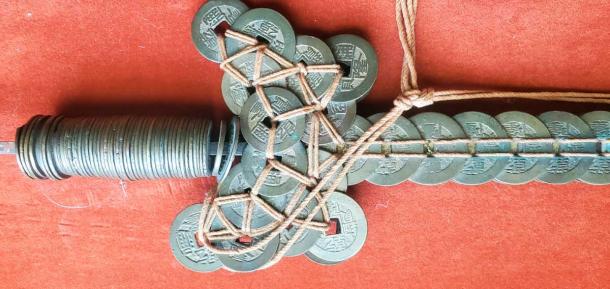
Ancient Chinese Coin Swords: Demon Fighting Weapons of the East
One of the most fascinating discoveries from ancient China are coin swords. Coin swords, also known as cash swords, are an ancient type of feng shui talisman that has been around since the Qing dynasty. These unique swords, while large and intricate, were not used in physical fights with others. Instead, Chinese coin swords were used to ward off evil and are frequently still used in Daoist rituals.

A Chinese coin sword-shaped talisman made from Qing dynasty era cash coins on display at the Museum of Ethnography, Sweden. (Etnografiska Museet / CC BY 2.5)
Coin Swords: Powerful Daoist Demon Fighters
Although it is not entirely clear when the first Chinese coin sword was crafted, legend holds that the first one was created sometime between the 26th and 24th centuries BC. It is believed that they were created during the reign of the Yellow Emperor, one of China’s mythological emperors and Daoist patron saints. Around the 7th century BC, these fascinating coin swords became associated with the notion that they could be used to fight evil spirits. However, this information was not yet widespread and was only practiced in small communities.
- Warding Evil and Welcoming Luck: Protective Amulets of the Ancient World
- Chinese Knife Money: Making Markets feel Murderous?

Huangdi Temple - Statue of Huangdi, the "Yellow Emperor" (Gary Todd / Public Domain)
These swords became much more popular over a millennium later, during the Liu Song dynasty. At this point, coin swords were being used regularly in religious rituals. Daoists used these swords in their rituals the most, fully believing that they were the key to driving out evil spirits. Believers in the swords spread the word that demons and other evil entities were scared of the swords thanks to Zhong Kui, a Daoist deity. Zhong Kui was known as the vanquisher of evil beings, and typically wielded a sword to slay these entities. Young Daoists were taught how to handcraft these cash swords quickly to protect themselves and their loved ones from these spirits. Later, swords sometimes had additional elements, such as astrological engravings, to give them more spiritual power.
- From Barter to Bitcoins: The 5,000 Year History of Money
- When – and Why – Did People First Start Using Money?

Zhong Kui, the demon queller, is seen waving his sword at five bats representing the five blessings, as if symbolically bringing these fortunes down to someone as recipient, depicted in a late 19th or early 20th century xylograph (Public Domain)
Daoist rituals still use Chinese coin swords regularly in their practices. In some rituals, a Daoist priest will wrap a red cloth around the hilt of the sword to bring its full spiritual power out. In homes, both real and replica cash swords can be hung up in the home above beds, doors, windows, or any other area of access or vulnerability to keep evil away. Evil spirits that see a coin sword in a building will not enter out of fear that Zhong Kui will use it to destroy them.
Daoists believe that the most powerful swords are those crafted from coins produced during the Qing dynasty. Some of these coins have the name Kangxi Tongbao inscribed on them, as this emperor reigned for an entire cycle of the Chinese calendar (60 years!). Coins swords produced with his name are considered to be stronger, due to their association with longevity. Plus, the name Kangxi translates into ‘prosperity’ and ‘good health,’ which only further strengthens the significance of these swords.

A coin sword talisman made from Qing Dynasty-based imitation cash coins. (Donald Trung / CC BY SA 4.0)
What Makes a Powerful Demon-Fighting Coin Sword?
Coin swords have a unique composition to make them work properly. Typically, the sword would be made of coins wrapped around an iron rod as a sturdy foundation. If the coin sword was particularly large, it may have a core of two iron rods to make it stronger. The Chinese coins would then be bound together by string, cord, or wire and wrapped around the iron core. Every detail of the sword matters, including color. Most of the time, the cord or wire holding the coins together would be red or gold, as these were often colors signifying royalty.
Chinese coin swords weren’t just randomly crafted. Most of them were made of a set number of coins, so they could be easily replicated in the future. A general coin sword would typically be made of 18 coins on the blade, 10 on the hilt, 6 on the handle, and 2 around the handle butt. The sword would also be 3 coins thick in all areas to make it sturdier. Doing the math, that means these swords were typically built with at least 108 copper-alloy Chinese coins.

Close-up of a coin sword hilt (wrea90 / CC BY SA 4.0)
On average, these coin swords are around 2 feet (0.6 meters) in length and 1-2 pounds (0.45-0.9 kilograms) in weight. However, the weight could be more, depending on the types of coins used and the overall size of the sword. Coin swords that were scaled up to be larger would of course weigh more. Shorter swords took fewer coins to produce and would therefore be lighter. Some Chinese coin swords were made with fake coins, which would sometimes result in a lighter sword.
It is important to note that the types of coin used to make the sword does matter significantly. Those that believe in the power of Chinese coin swords also believe that these swords can only work properly if made using coins produced during the time of a single emperor. Mixing coins between different dynasties is considered bad luck and can result in a faulty sword. It is also believed that ancient coins are more effective than modern coins, as they may have more power to fend off evil spirits due to their age.

19th century Qing Dynasty coin sword and accessories on display in Munich, Germany (Dr. Meierhofer / CC BY SA 3.0)
Fight Evil with Your Own Sword, or Visit One Yourself
We’ve all seen items made from money, but Chinese coin swords really take it to the next level. These swords are fascinating to see in real life and are sometimes still made today. There are many artisans, both in and out of China, who specialize in making these cash swords for feng shui or other spiritual purposes. Some of the most ancient Chinese coin swords are also on display at a variety of museums worldwide, so you don’t necessarily have to go to China to see one for yourself. If you ever find yourself needing to fight evil, find yourself a Chinese coin sword to give you a hand.
Top image: Coin sword made of an iron rod with Chinese cash coins of the 19th century tied to it with red and green string in the shape of a sword, with hanging ornaments. Source: British Museum / CC BY NC SA 4.0
By Lex Leigh
References
Coin-Sword: British museum. n.d. The British Museum. Available at: https://www.britishmuseum.org/collection/object/C_1974-0910-1
Feng Shui. May 20, 2022. National Geographic Society. Available at: https://education.nationalgeographic.org/resource/feng-shui
Huangdi. February 14, 2018). Encyclopedia Britannica. Available at: https://www.britannica.com/topic/Huangdi
Jiang, F. January 4, 2022. Song dynasty history (960–1279). Song Dynasty (960–1279), History and Culture of Northern Song and Southern Song. Available at: https://www.chinahighlights.com/travelguide/china-history/the-song-dynasty.htm
Swords and amulets. n.d. Primal trek. Available at: https://primaltrek.com/sword.html
The Chinese Coin Sword is a tool that combats aggressive Sha Chi. January 8, 2020. FengShuied. Available at: https://www.fengshuied.com/coin-sword














